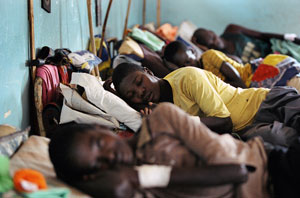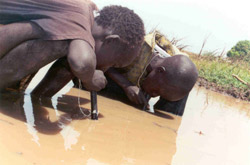
Sufferers of sleeping sickness
Imagine living day to day in a place plagued by constant poverty and unimaginable disease. AIDS, African trypanosomiasis (sleeping sickness), dracunculiasis (guinea worm disease), malaria, nodding syndrome, and onchocerciasis (river blindness) are some of the most common diseases the people of southern Sudan have to live in constant fear of. Although some of the diseases widespread in southern Sudan such as AIDS and malaria are also found elsewhere, southern Sudan is also plagued by some of the more exotic diseases such as guinea worm disease, nodding syndrome, river blindness, and sleeping sickness that are almost entirely local to Sudan and neighboring African countries. For instance, Sudan is known to have 80 percent of the world’s reported Guinea worm cases; practically all of these cases are in the war-torn region of southern Sudan. Guinea worm disease is a parasitic worm infection that people get when drinking infected water. Inside the human body, the larvae mature, growing as long as 3 feet and eventually escaping their hosts by punching a blister through the leg and crawling out over the course of a few days.

Trypanosoma brucei, the protozoon responsible for sleeping sickness.
As destructive and devastating as sleeping sickness is, the saddest part of the tragedy is the fact that sleeping sickness is a curable disease. If detected early from serological tests and/or checking for clinical signs, appropriate medication can be given. Currently, Pentamidine (for Trypanosoma brucei gambiense) and Suramin (for Trypanosoma brucei rhodesiense) provide first stage treatment and Melarsoprol and Eflornithine (for Trypanosoma brucei gambiense) for second stage treatment. First stage treatment is highly desirable as second stage treatment significantly increases undesirable and even life threatening side effects. For example, Melarsoprol is made of 20 percent arsenic and can melt ordinary plastic IV tubes. If melarsoprol manages to seep out of the veins it can cause enough severe damage to result in amputation. For second stage treatment, Eflornithine can be used as an alternative to Melarsoprol. Eflornithine is less toxic than Melarsoprol but the regimen is strict and difficult to apply. Unfortunately, Eflornithine is not effective against the Trypanosoma brucei rhodesiense form of sleeping sickness. However, it is effective against the Trypanosoma brucei gambiense form which represents more than 90% of the reported cases of sleeping sickness according to the World Health Organization (WHO).
The question that arises is how can the developed countries and those able to help the people of Sudan and others suffering from rare or geographically-confined diseases. There are many problems these people face, but I see at least three major hurdles:
- Constant war has continuously kept help away and forced people to live in extreme poverty and poor sanitation. One result being that health services is practically non-existent and the population depends entirely on outside volunteers and support.
- The fact that many of the diseases are not currently a threat to the developed nations where much of the medical research is done does not provide a sense of urgency and incentive for those nations to push the matter. Just think of the news swine flu made after barely becoming a threat to some of the more developed countries.
- The high cost of drug development means that the market for a drug has to be large enough to compensate for the risk and costs concerned with producing that drug. A disease that is rare and localized to a poor population does not provide as much incentive for those willing to take the risk and invest the money. And even when a viable drug is available, the costs of production and distribution still exist.

Sudanese boys using pipe filters to prevent Guinea worm disease.
However with diseases spread by mosquitoes/flies such as malaria, river blindness, and sleeping sickness, the key will be improved methods for mosquito control and access to new drugs and vaccines. Funding is obviously the major issue. Many afflicted people today depend on the good will of charitable foundations and donations of vaccines and drugs from drug companies and other organizations. Further, outbreaks of dangerous pathogenic agents such as Ebola and new mysterious diseases such as nodding syndrome further complicate matters and brings more misery and fear for the already impoverished people of so many poor nations.
To help the people of Sudan and other impoverished countries, it will take a global effort on the part of volunteers, organizations, drug companies, and local governments. There is much work to be done to eradicate diseases and setup a sanitary environment to prevent future outbreaks.
Additionally, more research into parasites such as trypansomes may lead to advanced break-throughs in other areas of medical research. Trypansomes are easily able to evade the immune responses by periodically switching their major variant surface glycoprotein (VSG), a phenomenon called antigenic variation. As trypanosomes multiply in the bloodstream, the host eventually mounts an antibody response against trypanosomes expressing a given VSG. Interestingly, as trypanosomes can switch to new VSG coat variants not recognized by host antibodies, these can evade antibody mediated lysis and form the next round of infection. Think of it as your immune system identifying an intruder and just as the intruder is identified, it switches coats and the immune system knows no better and the cycle continues repetitively. This is likely only one of many mechanisms enabling this parasite to easily deceive the immune defenses.
Realize this – most people carry parasites. Over 1.4 billion people (or about a quarter of the world population) are infected with with the snakelike roundworm Ascaris lumbricoides that lives in the intestines, 1.3 billion carry blood-sucking hookworms, and about 1 billion have whipworm. Sure these specific parasites are all treatable, but think of the millions of parasites that exist, many of which are still undiscovered and may be the root causes of diseases such as Alzheimer’s or Parkinson’s.




 Twitter
Twitter LinkedIn
LinkedIn Youtube
Youtube RSS
RSS
Pingback: What are governments doing to eradicate Guinea Worm disease? | News and Gossip | newsgossip.org